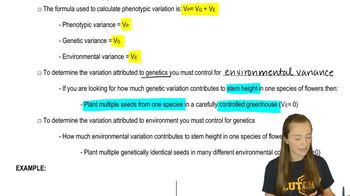Table of contents
- 1. Introduction to Genetics51m
- 2. Mendel's Laws of Inheritance3h 37m
- 3. Extensions to Mendelian Inheritance2h 41m
- 4. Genetic Mapping and Linkage2h 28m
- 5. Genetics of Bacteria and Viruses1h 21m
- 6. Chromosomal Variation1h 48m
- 7. DNA and Chromosome Structure56m
- 8. DNA Replication1h 10m
- 9. Mitosis and Meiosis1h 34m
- 10. Transcription1h 0m
- 11. Translation58m
- 12. Gene Regulation in Prokaryotes1h 19m
- 13. Gene Regulation in Eukaryotes44m
- 14. Genetic Control of Development44m
- 15. Genomes and Genomics1h 50m
- 16. Transposable Elements47m
- 17. Mutation, Repair, and Recombination1h 6m
- 18. Molecular Genetic Tools19m
- 19. Cancer Genetics29m
- 20. Quantitative Genetics1h 26m
- 21. Population Genetics50m
- 22. Evolutionary Genetics29m
20. Quantitative Genetics
Analyzing Trait Variance
Problem 22d
Textbook Question
Textbook QuestionSuppose a polygenic system for producing color in kernels of a grain is controlled by three additive genes, G, M, and T. There are two alleles of each gene, G₁ and G₂, M₁, and M₂, and T₁ and T₂. The phenotypic effects of the three genotypes of the G gene are G₁G₁ = 6 units of color, G₁G₂ = 3 units of color, and G₂G₂ = 1 unit of color. The phenotypic effects for genes M and T are similar, giving the phenotype of a plant with the genotype G₁G₁M₁M₁T₁T₁ a total of 18 units of color and a plant with the genotype G₂G₂M₂M₂T₂T₂ a total of 3 units of color. How many units of color are found in trihybrid plants?
 Verified Solution
Verified SolutionThis video solution was recommended by our tutors as helpful for the problem above
Video duration:
3mPlay a video:
173
views
Was this helpful?
Related Videos
Related Practice

